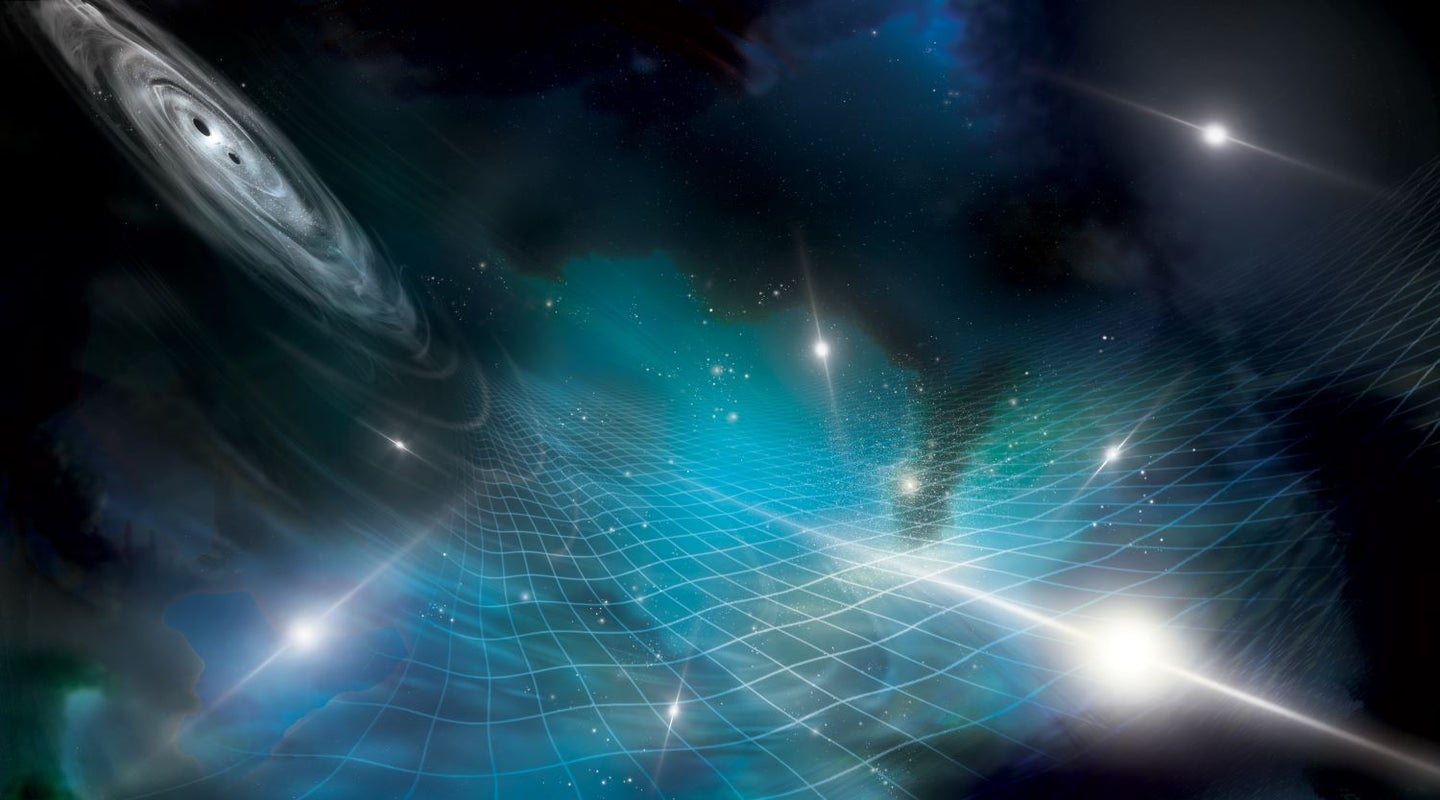Astronomers used dead stars to detect a new form of ripple in space-time
Longer gravitational waves from colliding black holes could help explain why galaxies grow and change.

Today, a humongous team of astronomers called the NANOGrav Collaboration announced something remarkable: the first evidence for a background hum of gravitational waves that permeates our universe. The research group, based in the US and Canada, used dead stars across the galaxy as a Milky-Way-sized measurement device to find these distorting undulations.
“We’ve been on a mission for the last 15 years” to find this background, said Stephen Taylor, Chair of NANOGrav and Vanderbilt University astronomy, in a press briefing. “And we’re very happy to announce that our hard work has paid off.” These waves can reveal the kinds of black holes scattered across the cosmos, which will help astronomers figure out how galaxies grow and change.
Gravitational waves are ripples in the fabric of space-time itself. Just like telescopes are specialized for different parts of the electromagnetic spectrum, gravitational wave experiments are sensitive to different wavelengths, too. The LIGO experiment, which found the first gravitational waves in 2016, can detect shorter waves, like those made when two star-sized black holes smash together. But it can’t feel longer, lower frequency waves, which some astronomers think are key to unlocking the universe’s history.
“If we want to observe the largest black holes to further understand galaxy evolution, as well as test theories at the frontiers of modern physics, we need to be able to observe low-frequency gravitational waves,” says Vanderbilt University astronomer William Lamb, who is part of the NANOGrav team.
[Related: Astronomers recorded a whopping 35 gravitational wave events in just 5 months]
Such waves come from the most massive black holes, which should be merging all across the universe to create background noise, like cosmic TV static. For a while, astronomers worried these monster black holes could never get close enough to combine into one galactic center, which would be a big problem for our understanding of galaxies’ evolution—and would result in a quieter gravitational wave background. Since NANOGrav has heard the signal, now astronomers know these black holes do collide, and they can figure out the details of how galaxies merge. Gravitational waves from right after the Big Bang might also contribute to this background, offering one way to probe the first seconds of the universe.
To detect such a low-frequency signal, astronomers needed an experiment larger than the entire Earth—possibly something the size of the whole galaxy. Luckily, nature provided just the tool: pulsars. Pulsars are the dead cores of the heaviest stars, which spew out jets of light and spin unbelievably fast. Like watching the beams from a lighthouse, we see them pulse brighter when their jet spins toward us—and somehow nature is the best lighthouse keeper, since pulsars are as predictable in their timing as atomic clocks.
When these pulsars ride the swell of a gravitational wave, though, the space-time ripple distorts this precision. Pulsar timing arrays (PTAs), collections of radio telescopes that record pulsars across the galaxy and can measure these minute deviations in pulsars’ otherwise super-accurate clocks. Together, the many tiny shifts in pulsars’ periods paint a picture of how a long, low-frequency gravitational wave propagates throughout the galaxy. To make these measurements, NANOGrav used telescopes across North America: Puerto Rico’s famed Arecibo Telescope (which has since collapsed), the Green Bank Telescope in West Virginia, the Very Large Array in New Mexico, and the CHIME experiment in Canada.

Pulsar timing “is fundamentally different from how LIGO detects gravitational waves,” says University of Mississippi astronomer Sumeet Kulkarni, who was not involved in the new work. “What I find particularly amazing about this discovery is the coordination involved” between the numerous telescopes and contributors, he adds.
This new result uses 15 years of data from NANOGrav’s PTAs, but it isn’t quite robust enough for the team to call it an official detection. Instead, the researchers are using the term “strong evidence.” But because the signal builds up with time, they’re confident that they’ll have a clear-cut detection in a few years. “We’ll be able to produce better and better maps of the gravitational wave sky,” said Luke Kelley, a University of California, Berkeley astronomer and NANOGrav team member, in a press briefing.
[Related: Gravitational waves just showed us something even cooler than black holes]
Full implications of this detection are yet to be understood, but studies of these low-frequency waves are only beginning. Members of the International Pulsar Timing Array have similar data from across the world, including Australia, China, and India. These measurements will be even more powerful when astronomers bring them all together, possibly within the next year.